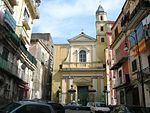AD 62 Pompeii earthquake
1st-century natural disasters1st-millennium earthquakes1st century in Italy60s in the Roman Empire62 ... and 4 more
Earthquakes in ItalyEarthquakes in the Roman EmpireHerculaneum (ancient city)Pompeii (ancient city)
On 5 February AD 62, an earthquake of an estimated magnitude of between 5 and 6 and a maximum intensity of IX or X on the Mercalli scale struck the towns of Pompeii and Herculaneum, severely damaging them. The earthquake may have been a precursor to the eruption of Mount Vesuvius in AD 79, which destroyed the same two towns. The contemporary philosopher and dramatist Seneca the Younger wrote an account of the earthquake in the sixth book of his Naturales quaestiones, entitled De Terrae Motu (Concerning Earthquakes).
Excerpt from the Wikipedia article AD 62 Pompeii earthquake (License: CC BY-SA 3.0, Authors).AD 62 Pompeii earthquake
Via Passeggiata Archeologica,
Geographical coordinates (GPS) Address Nearby Places Show on map
Geographical coordinates (GPS)
| Latitude | Longitude |
|---|---|
| N 40.7 ° | E 14.5 ° |
Address
Via Passeggiata Archeologica
Via Passeggiata Archeologica
80053
Campania, Italy
Open on Google Maps









